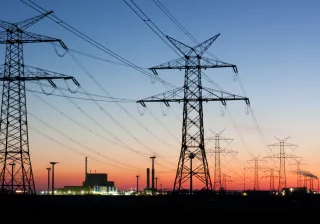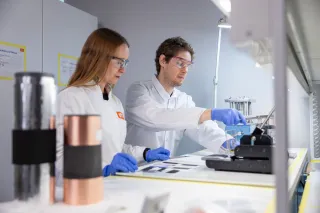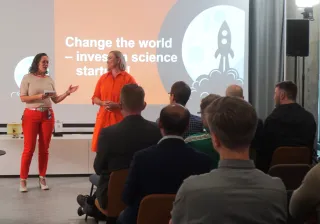The energy sector is in transition around the world. Policy makers have awoken to the acute need to combat climate change, but the energy policy outlines of the future are still being debated. A particular topic of debate is the role of nuclear power as a means of reducing greenhouse gases.
Life-cycle assessments place nuclear power in the same size category as, say, wind power in terms of greenhouse gas emissions. On the other hand, nuclear power plants can produce relatively cheap electricity with steady efficiency.
The idea of increasing the use of nuclear energy provokes strong reactions in many people, despite the number of factors in its favour. Use of nuclear energy involves the possibility of a major radiological accident. For this reason, safety issues always arise sooner or later in discussions of nuclear power. However, what is meant by nuclear safety, is not always clear.
Jaakko Leppänen, VTT's Research Professor responsible for reactor safety, wants to promote the safe use of low-emission nuclear energy and highlight the facts about nuclear safety. He believes that Finland has a good basis for nuclear power: the high operating factors of our plants in global terms bears testimony to our high expertise and excellent safety culture.
Leppänen's role at VTT as a research professor in reactor safety involves the computational modelling of reactor cores and the development of safety analysis tools. In addition, reactor modelling is closely linked to other areas of nuclear technology, such as power plant modelling, radiation protection and final disposal of spent nuclear fuel. Leppänen is also responsible for arranging the training of a new generation of experts, to ensure that Finland continues to have sufficient worldclass expertise.
– Finland is committed to the long-term use of nuclear energy, which will require long-term maintenance and development of the sector's expertise. There is a great need for new experts now and in the future, Leppänen points out.
SMR reactors are a future trend
Nuclear power plants currently produce around 17 percent of electricity consumed around the world, or about seven percent of total energy consumption. The share of nuclear power is considerably higher in certain regions: it accounts for around one third of the European Union's and almost half of Sweden's electricity production.
Four light water reactors, which produce about one third (33.7%) of the country's electricity consumed each year, are being used in Finland. Alongside hydroelectric power (23.6%), nuclear power accounts for the largest share of low-carbon power generation. Other renewables come next: biomass (16.3%) and wind power (4.6%).*
– The Olkiluoto three reactor, to be commissioned next year, will increase the share of nuclear power. In the longer run, development will depend on the completion schedule of Fennovoima's Hanhikivi project and the decommissioning of old plants, says Leppänen.
Although the future of energy policy is particularly unclear in Europe, Leppänen believes that nuclear energy will continue to play an important role in reducing greenhouse gas emissions. Future trends in the nuclear sector include Small Modular Reactors (SMRs) and extending the use of nuclear energy from power generation to industrial processes.
SMRs, whose sizes range from a few dozen to few hundred megawatts, could also be applied to more than just power generation. Potential applications in the Finnish energy system might include district heat production and large industrial plants, for example.
– High-temperature SMRs have major potential for reducing carbon dioxide emissions in sectors such as the steel and concrete industry, where emissions are difficult to lower using other technologies. There has also been a great deal of media discussion about using nuclear power to 'clean up' district heating in big cities, says Leppänen.
Nuclear safety is a hot topic – what does it consist of?
Safety issues are being discussed because using nuclear energy involves the risk of a major radiological accident. However, it is not always clear what nuclear safety involves, and from where threats to the safe use of reactors could emerge.
According to Leppänen, every operating nuclear reactor produces radioactive isotopes, which must be effectively isolated from the environment. More than 99% of this radioactivity is generated in solid uranium dioxide pellets, which are sealed in gas-tight metal cladding tubes.
According to Leppänen, the risks of radioactive emissions lie in the overheating of the reactor core, when the fuel loses its integrity and, in the worst case scenario, melts down. The fundamental goals of nuclear safety involve maintaining the coolant flow in all imaginable conditions, and if the integrity of the fuel is compromised, preventing radioactive emissions to the environment by multiple successive barriers.
Unlike conventional coal, natural gas and biofuel plants, a nuclear reactor does not produce any flue gas emissions. All processes involving radioactive materials are isolated from the surrounding environment.
– Reactor coolant flows in a closed cycle. Heat is transferred from one loop to the next via heat exchanges, and since the sea water in the outermost loop never passes through the reactor core, it is not activated by neutrons either.
However, Leppänen points out that such isolation is never perfect and every nuclear power plant releases some radioactive emissions into the air and waterways. Continuous measurements are used to monitor that these emissions remain within their set limits. In practice, emission limits are determined on the grounds that the radiation exposure of the environment and population close to a nuclear plant must remain insignificantly small in comparison to the dose from natural background radiation.
The risk of large emissions lies instead in accidents where significant amount of radioactivity is released from fuel.
– For example, according to some estimates, the Chernobyl nuclear accident of 1986 released some 2 EBq (exabecquerels, 2E18 Bq) of radioactive iodine into the environment. This figure can be compared to the annual iodine emissions from Loviisa or Olkiluoto, which have been in the range of one gigabecquerel (1E9 Bq) at most.
Leppänen says that this difference in magnitude of billions is explained by the fact that, as long as the fuel remains intact, the radioactivity remains bound to solid uranium dioxide pellets within a gas-tight cladding tube.
– In addition to extensive fuel damage, releases of radioactivity into the environment would require the failure of the other successive release barriers; in other words, loss of the air-tightness in the pressure-resistant containment building around the reactor.
Risks down to a minimum, focus on the reactor's decay heat
The main threats to fuel integrity are related to sudden power transients and overheating caused by insufficient cooling. The fuel cladding begin to sustain damage when the temperature rises above 650 degrees, or about 300 degrees above the reactor's normal operating temperature. A phase change occurs in a zirconium alloy cladding tube at about 800 degrees, after which it begins to oxidise rapidly. This reduces the durability of the material and hydrogen is released in the process.
According to Leppänen, in serious reactor accidents the temperatures may rise so high that even the uranium dioxide fuel tablets melt. The severity of damage to the core also affects the release of radionuclides. For example, iodine isotopes form volatile compounds at temperatures of just a few hundred degrees, but the release of strontium requires temperatures high enough to melt the fuel.
– In sum, the ultimate challenge in reactor safety therefore lies in keeping the fuel temperature within safe limits in all possible operating conditions.
According to Leppänen, the operational risks posed by a nuclear reactor do not, contrary to popular belief, involve loss of control of fission power, as occurred in the Chernobyl accident of 1986. This is because in most reactor types the chain reaction is maintained in an inherently stable state. The main threat to fuel integrity is instead the so-called decay heat, which originates from the radioactive decay of short-lived isotopes. This means that the thermal power of the reactor does not fall to zero immediately after shutdown, but remains at a level sufficient to melt the fuel if coolant circulation is lost for an extended period of time. According to Leppänen, light water reactor safety largely involves ensuring that the reactor core remains sufficiently cooled in all possible conditions, including when the reactor is shut down.
– In modern nuclear power plants, this means providing reliable emergency power for coolant pumps even in situations where the systems used for normal operation are compromised or unavailable. In most cases, emergency cooling is ensured by several redundant systems, making complete loss of power virtually impossible.
New technology is improving reactor safety
The European Pressurized Water Reactor (EPR) facility being built at Olkiluoto is a representative of fairly traditional reactor technology. Leppänen comments that the same is true of the AES-2006 facility planned by Fennovoima.
– The key safety improvements lie in the fact that these new plants have been designed to cope with a serious reactor accident in which the core melts through the bottom of the reactor pressure vessel. In addition, the structures and safety functions are designed to better withstand external threats, such as the impact of a large passenger aircraft.
Leppänen adds that new safety technology includes passive cooling systems based on natural convection, which require no external power whatsoever to function. Such systems are especially designed for SMR-scale reactors. Using passive systems, the removal of the reactor's decay heat can be ensured without complex and costly multi-secured diesel generators and other backup power systems.
– Some advanced reactor types can be rendered inherently safe with regard to the removal of decay heat. For example, the power density of gas-cooled pebble-bed reactors is so low and the materials are designed to withstand such high temperatures that emergency cooling systems may not even be necessary.
According to Leppänen, the inherent safety related to low power density could also be used in the design of light water reactors for district heating, which, unlike conventional pressurized and boiling water reactors, do not require a high temperature or pressure to operate.
*According to statistics collected by the energy industry for 2016
Nuclear waste management done safely
Finland's final disposal solutions are ahead of the game. Safety research on nuclear waste disposal has been underway since the 1970s, and the first capsules will be taken to the Posiva repository during the next decade.
According to Jaakko Leppänen of VTT, the final disposal concept is based on the same type of multi-barrier principle as reactor safety. Radionuclides generated in the spent fuel are isolated from the environment by multiple, successive release barriers. Designs are based on highly conservative assumptions, and various scenarios can be used to evaluate unexpected conditions.
– Safety planning, projecting thousands of years into the future, is based on the idea that the exposure of people to radiation released from the final disposal site remains negligible compared to the dose of natural background radiation, says Leppänen.





